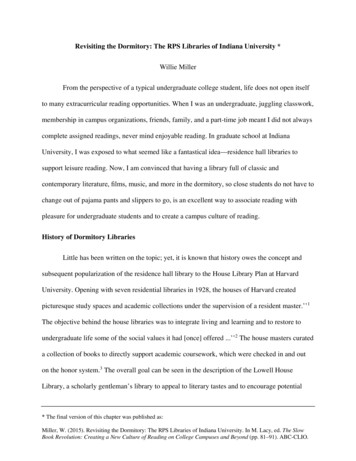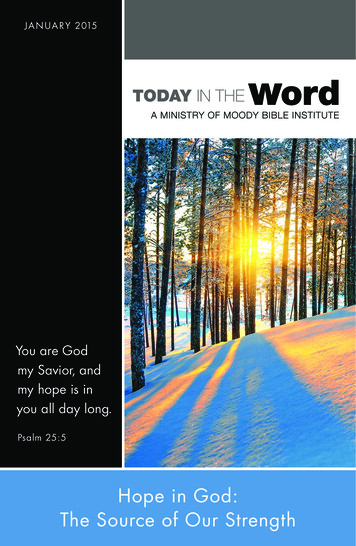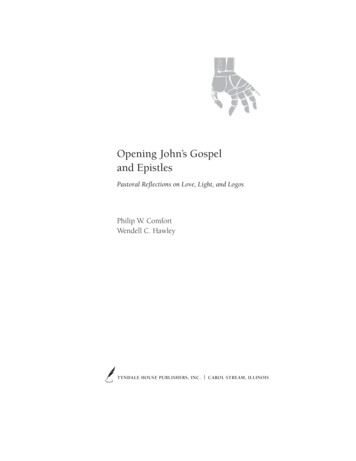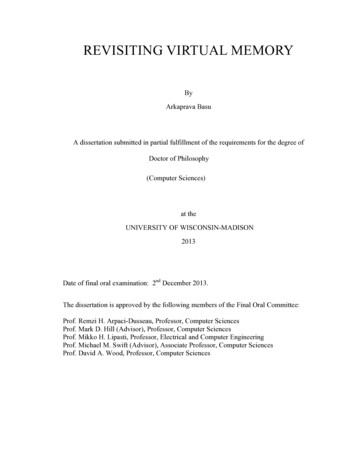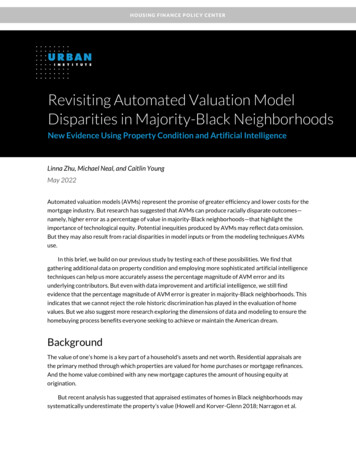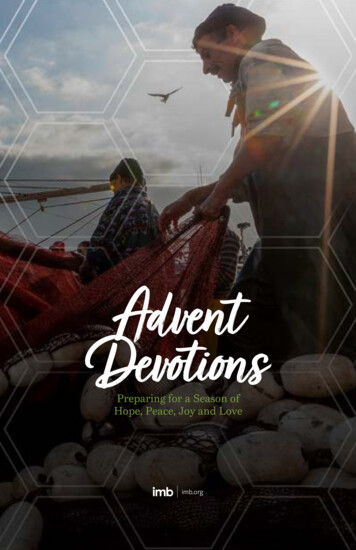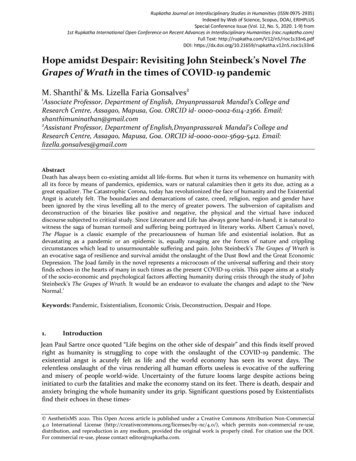
Transcription
Rupkatha Journal on Interdisciplinary Studies in Humanities (ISSN 0975-2935)Indexed by Web of Science, Scopus, DOAJ, ERIHPLUSSpecial Conference Issue (Vol. 12, No. 5, 2020. 1-9) from1st Rupkatha International Open Conference on Recent Advances in Interdisciplinary Humanities (rioc.rupkatha.com)Full Text: http://rupkatha.com/V12/n5/rioc1s33n6.pdfDOI: 3n6Hope amidst Despair: Revisiting John Steinbeck’s Novel TheGrapes of Wrath in the times of COVID-19 pandemicM. Shanthi1 & Ms. Lizella Faria Gonsalves21Associate Professor, Department of English, Dnyanprassarak Mandal’s College andResearch Centre, Assagao, Mapusa, Goa. ORCID id- 0000-0002-6114-2366. Email:shanthimuninathan@gmail.com2Assistant Professor, Department of English,Dnyanprassarak Mandal’s College andResearch Centre, Assagao, Mapusa, Goa. ORCID id-0000-0001-5699-5412. Email:lizella.gonsalves@gmail.comAbstractDeath has always been co-existing amidst all life-forms. But when it turns its vehemence on humanity withall its force by means of pandemics, epidemics, wars or natural calamities then it gets its due, acting as agreat equalizer. The Catastrophic Corona, today has revolutionized the face of humanity and the ExistentialAngst is acutely felt. The boundaries and demarcations of caste, creed, religion, region and gender havebeen ignored by the virus levelling all to the mercy of greater powers. The subversion of capitalism anddeconstruction of the binaries like positive and negative, the physical and the virtual have induceddiscourse subjected to critical study. Since Literature and Life has always gone hand-in-hand, it is natural towitness the saga of human turmoil and suffering being portrayed in literary works. Albert Camus’s novel,The Plague is a classic example of the precariousness of human life and existential isolation. But asdevastating as a pandemic or an epidemic is, equally ravaging are the forces of nature and cripplingcircumstances which lead to unsurmountable suffering and pain. John Steinbeck’s The Grapes of Wrath isan evocative saga of resilience and survival amidst the onslaught of the Dust Bowl and the Great EconomicDepression. The Joad family in the novel represents a microcosm of the universal suffering and their storyfinds echoes in the hearts of many in such times as the present COVID-19 crisis. This paper aims at a studyof the socio-economic and psychological factors affecting humanity during crisis through the study of JohnSteinbeck’s The Grapes of Wrath. It would be an endeavor to evaluate the changes and adapt to the ‘NewNormal.’Keywords: Pandemic, Existentialism, Economic Crisis, Deconstruction, Despair and Hope.1.IntroductionJean Paul Sartre once quoted “Life begins on the other side of despair” and this finds itself provedright as humanity is struggling to cope with the onslaught of the COVID-19 pandemic. Theexistential angst is acutely felt as life and the world economy has seen its worst days. Therelentless onslaught of the virus rendering all human efforts useless is evocative of the sufferingand misery of people world-wide. Uncertainty of the future looms large despite actions beinginitiated to curb the fatalities and make the economy stand on its feet. There is death, despair andanxiety bringing the whole humanity under its grip. Significant questions posed by Existentialistsfind their echoes in these times AesthetixMS 2020. This Open Access article is published under a Creative Commons Attribution Non-Commercial4.0 International License (http://creativecommons.org/licenses/by-nc/4.0/), which permits non-commercial re-use,distribution, and reproduction in any medium, provided the original work is properly cited. For citation use the DOI.For commercial re-use, please contact editor@rupkatha.com.
2Rupkatha Journal, Vol. 12, No. 5, 2020“Don't you have the impression that we are living .if we can call that living.in a brokenworld? Yes, broken like a watch has stopped. Its mainspring no longer works. To allappearances nothing has changed. Everything is in place. But if you put that watch to yourear.you hear nothing. Remember, the world, or what we call the world, the humanworld.used to have a heart. But it seems that heart has stopped beating.” (Marcel, 1998,31-42).The existential crisis is palpable with changes surging humanity on a quest for survival.Change is the constant in the present times and as welcoming it would otherwise be, it bringsalong with it an overwhelming sense of anxiety. But, in the changing tide of affairs, relooking atthings and ideas from a different perspective is needed to maintain equanimity. In fact, evenanxiety produces the necessity for self-introspection. It is not surprising that history repeats itselfand impresses upon humanity that Death is a resident among all Life forms and therefore wouldmake its presence intensely felt from time to time.Throughout human history, the world has witnessed significant and life changing calamitiesand disasters which has constantly allowed humanity to realize the precariousness of life. All ofthese natural and man-made disasters have brought home the truth that human existencedepends on the delicate balance of natural, scientific and supernatural forces. Any imbalancemight result in cataclysmic events. And in the face of any calamity, people lose their equilibrium,and struggle to find their moorings. Deprived of security, human beings are left to ponder overtheir state of existence and the meaning of life. As Karl Jaspers in Philosophy, Volume 2 states,“The discontent of possible self-being has broken through mundane existence and castthe individual back upon himself, back to the origin that lets him deal with his worldand.realize his existence” (1969, 9).Dealing with any tragedy requires strength and courage. In the face of insurmountabledifficulties with others facing the same problems, poses a challenge. With limited options, deathseems an easy way out but the urge to survive is equally persistent. Throughout the dark episodesof disasters and calamities, human resilience has retained its glimmer of hope. According toKubler Ross Model, a person facing any misfortune undergoes five major stages- (i) Denial (ii)Anger (iii) Bargain (iv) Depression (v) Acceptance (Five stages of Grief). Application of this theoryto the present COVID-19 crisis seems plausible with reports indicating the increasing number ofcases of depression and domestic violence. The impact of tragic events certainly takes a toll on thepsychological well-being of a person. A prolonged period of denial leads to heightened state ofsadness and builds up anger. Depression therefore seeps in a mind soaked with despair which canonly be relieved by accepting the situation. Acceptance of the situation produces a hopefuldespair. Hope, therefore resides in resilience which envisages a better tomorrow.All good literature contains ideas-expressing universal truths holding the potential toactivate hope and revaluate life. Such ideas have changed the trajectory of many lives. Literaturealways anticipates what is going to come, it does not copy but moulds it to its purpose. Theliterary texts reflect the age and create new narratives conducive to innovation and change.Therefore, assessing literary works offers the scope of providing insights about life in all itsdimensions.The COVID-19 pandemic provides a comparative case scenario as depicted in many literaryworks like Albert Camus’s The Plague or Daniel Defoe’s A Journal of the Plague Year. AlbertCamus in his novel, The Plague, presents the horrific scenario of the devastation caused by theepidemic of Plague in the fictional town of Oran. It is interesting that death, devastation andsuffering produces a remarkable change in the behaviour of people. The obsession with self-
3 Hope amidst Despair: Revisiting John Steinbeck’s Novel The Grapes of Wrath in the times of COVID-19 pandemicpreservation renders people helpless bringing to the fore even abhorring attitudes. Camus alsomakes the proposition that “everyone has inside it himself this plague, because no one in theworld, no one, can ever be immune” (Camus 2009, 195).Likewise, A Journal of the Plague Year, too recounts incidents of suffering and death whichoccurred during the outbreak of the plague in London in 1665-1666. Many scenes portrayed in thebook give a sense of déjà vu in light of the present COVID-19 scenario.“ seeing they were all dead, and were to be huddled together into the common Grave ofMankind, as we may call it, for here was no difference made, but poor and rich wenttogether. There was no other way of burials, neither was it possible there should, for coffinswere not to be had for the prodigious numbers that fell in such a calamity as this” (Defoe1959, 63).“It is true, hundreds, yea, thousands of families fled away at this last Plague, but then ofthem, many fled too late and not only died in their flight, but carried the Distemper withthem into the countries where they went, and infected those whom they went among forsafety ” (Defoe 1959, 189).Another classic Srikant by Sharat Chandra Chattopadhyay highlights the grim picture of lifeamidst an epidemic“. this is the time that everyone was interested in preserving their own lives. No mother, nofather, no wife, no children, no relation, no friends, no acquaintances. It is just everyone tohimself. .a selfish age of self- preservation, nursing the infected means infection andultimate death” (1944, 275).The fear of death and self-preservation is the common thread in all such narratives aboutepidemics and disasters. The first impact of any such catastrophe is on the human mind attackingthe thoughts, senses and the actions. The resulting changes lead to a dichotomy between the realand the imagined. Fear, anxiety and social unrest gradually gathers momentum and there’s apolarization which occurs leading to systematic changes in the socio-economic set-up.The COVID-19 pandemic has resulted in binaries like, Local and Migrants, Indoor andOutdoor, Positive and Negative, Physical and Virtual and Social and Physical distancing. The needfor maintaining social distancing as a form of self-preservation is a requisite in the presentscenario and therefore, staying indoors and living in a virtual world has become the ‘NewNormal’. The breaking down of the prior order of proximities have facilitated a dynamic change inthe lifestyle of the people. There has also been marked alteration in the people’s perceptionregarding spatial factors demarcating people as locals and migrants.The migrant crisis in India during the lockdown presented a heart-rending scenario of thepropensity of the damage caused by the pandemic. Their story is a universal story raisinghumanitarian concerns and the resilience of the human spirit. For every villain, there is always ahero; the pandemic has brought to light numerous instances of discrimination against theCOVID-19 patients and even the health workers and doctors, there have been cases of violenceand humiliation, but, on the contrary, there have also been acts of surpassing kindness andgenerosity performed by mere ‘ordinary’ people. It is these benevolent deeds which can be laterrecalled and offer consolation in the dark period of despair.The migrant crisis also brought to the fore the worsening state of world economy which isreeling under the relentless onslaught of the corona virus. Anne Case and Deaton in Deaths of
4Rupkatha Journal, Vol. 12, No. 5, 2020Despair and the future of Capitalism highlight the flaws in capitalism and its effects on theworking class. They present a realistic world view,“Jobs are not just the source of money; they are the basis for the rituals, customs, androutines of working-class life. Destroy work and, in the end, working class life cannotsurvive. It is loss of meaning, dignity, of pride, and of self-respect” (2020, 16).Though the book was written prior to the outbreak of the pandemic with the focus onAmerica, yet, the alarming condition of the working class and the increasing cases ofunemployment aptly captures the grim situation in which we are all in today.As evocative has been the literature portraying the horrors of epidemics and humansuffering, John Steinbeck’s The Grapes of Wrath is equally incisive in its depiction of the strugglefaced by the migrant labourers due to the Dust Bowl in America in the backdrop the GreatEconomic Depression. His reason to write this novel was to vocalize the pitiable condition of thereal people who were uprooted and became vagrants due to the landowners and the Banks (whoin turn were rendered helpless by the Depression). The question however lies in the fact that whowere the victims and how humanely could the situation have been addressed.2.The Grapes of WrathThe Grapes of Wrath won the National book award, Pulitzer Prize and eventually won theNobel Prize too. Based on Steinbeck’s visit to the camps and shared experiences with themigrants, the novel is a representation of the ordeal faced by the displaced families struggling toretain their identity and dignity. The drought at Oklahoma compels the tenant farmers to leavetheir land. The hope of better prospects makes them embark on the journey to the ‘PromisedLand’- California. The narrative focuses on the Joad family and the challenging hardships theyface as they journey on Highway 66 experiencing death of Grandpa and Grandma, loss andseparation of other family members. Their arrival in California and the pitiable state to whichthey are reduced presents a sympathetic picture of their sense of indignation and injusticescrambling for jobs and surviving on meagre ration which later incites Jim Casey and Tom torebellion. Casey’s accidental death and Tom’s life as a fugitive further aggravates their misery.However, their fortitude and determination to survive proclaims a tale of heroism and Hopeamidst Despair with the novel ending on an unsettling yet optimistic note of Rose of Sharonbreast-feeding a starving man after delivering a still-born child. The novel raised awareness aboutthe devastation caused by the Dust Bowl to the farmlands and plight of the migrant workers withpolitical and activist movements arising as result of it.The situation of Covid-19 can be paralleled with the circumstances caused due to thedrought in Oklahoma, the monster ‘Corona’ can be equalized with the bank officers and largecorporations. The hostility which the people face as they travel to California is akin to thediscrimination and prejudice in the minds of most residents concerning the migrants. In thelarger spectrum of the pandemic, the human life appears trivial and the humanity at large cannotescape from the virus. Brian Railsback in his article The Darwinian Grapes of Wrath states thistruth,“The novel presents a large picture in which humans are only a small part; in the greatnatural scheme of sky and land, of rain, wind, and dust” (2007, 151).People were not prepared to face such a calamity as most of the people had a qualitativelife. With the sudden outbreak of the pandemic, the unexpected happened and people had towitness suffering, death and despair.
5 Hope amidst Despair: Revisiting John Steinbeck’s Novel The Grapes of Wrath in the times of COVID-19 pandemic3.Hope and DespairLife is meaningless without a sense of belongingness, as a sense of identity buildscommunities and fosters relationships. The displacement results in a loss of identity for thepeople as Ma Joad says, “They was the time when we was on the lan’. They was a boundary to usthen We was the fambly- kinda whole and clear. An’ now we ain’t clear no more.” (Steinbeck1992, 239)When the truck drivers come to dismantle the land under the directives of the Banks, thefarmers’ heart cries while witnessing their lands being taken away by the big monsters.Attachment to the land runs deep as one of the farmer says,“It’s our land .we were born on it, and we got killed on it. Even if it’s no good it’s stillours that’s what makes ownership. Not a paper with numbers on it” (1992, 35).The Dust Bowl, drought and the Banks in the backdrop of the period of Depression broughtthe worst affected people to utter ruin and despair. The Great Economic Depression was one ofthe blackest periods in the history of the world dismantling the very fabric of the society.Likewise, unimaginable economic strain due to COVID-19 has brought the world to a standstill.Many have lost their jobs and business owner have suffered tremendous losses. The financialstrain compounded by the psychological dilemma has resulted in the quest for survival. In anarticle Job Loss most severe immediate impact of Covid -19: Survey which was quoted had the sameconcept that “The loss of employment was considered as the most severe immediate impact ofcrisis” (Economic Times, 11th June, 2020).The novel portrays this predicament as the people are uprooted from their land and walk anomadic path with only Hope as their guiding light. They hope for a better life but what they getis humiliation and exploitation. The worst tragedy they encounter is, the inhumanity of theirfellow human beings. The sense of mortification and resentment is palpable as we realize theirsad saga-a sudden blow changed their destiny! Understanding their story through the Kubler Rossmodel offers a sympathetic insight, however getting fixated on any one stage would provesdisastrous. So also, the acceptance would lead either to adapting to change or bringing changethrough rebellion or activism.The labelling of these newcomers derisively as ‘Okies’ and the ramshackle camps termed‘Hooverville’ with atrocious acts of dumping potatoes in the rivers and burning the fruits whilepeople watch these with hungry eyes scream aloud of inhumanity.“There is a crime here that goes beyond denunciation. There is a sorrow here that weepingcannot symbolize. There is a failure here that topples all our success. The fertile earth, thestraight tree rows, the sturdy trunks, and the ripe fruit. And children dying of pellagra mustdie because a profit cannot be taken from an orange. And coroners must fill in thecertificates-died of malnutrition-because the food must rot, must be forced to rot”(Steinbeck 1992, 365).The division caused by class and economy is the root cause of most of the evil. Placed inarbitrary system of operation and being at the mercy of the Capitalists results in psychologicaland emotional strain. In the novel, each family member fights the despair through their own levelof perception and understanding. Pain runs through their lives but, the endearing quality ofthese suffering people lies in their sense of dignity and camaraderie.Although self-preservation is the key in times of crisis, with social-distancing being the key‘mantra’, the irony however lies in the fact that we can survive only as a community. This sense of
6Rupkatha Journal, Vol. 12, No. 5, 2020belongingness and uniting for a common cause is the beginning of the realization of the humanpotential for goodness.The indifference of the truck drivers and the land owners of California who are moreworried about the profit than the misery of the daily wage laborers is saddening. But against thisonslaught of injustice, The concept of ‘I’ changes into ‘we.’ Brian Railsback in The DarwinianGrapes of Wrath comments,“The migrant workers show a sense of compassion for their fellows that bind them togetherand eventually ensure their existence in a hostile environment, for the cooperation thatgrows out of sympathy is the greatest threat to the owners” (2007, 155).It is the sign of positivity that amidst hunger and deprivation of basic amenities, hopeshines out. When the men get into depression and despair, Ma Joad encourages them,“You ain’t got the right to get discouraged. This here fambly’s goin’ under. You jus’ ain’tgot the right” (Steinbeck 1992, 366).The psychological effect of the trauma of death, loss and anxiety is palpable in the survivorsof any tragedy. Sonali Acharjee in her article, The Covid Survivors in India Today highlights theneed to draw on the inner strength to fight the battle:“They have been to the edge of the Covid abyss and back. Some got away easy, othersstruggled with the stigma, the isolation and the disease. At the other side of the crisis now,all of them have one thing to say: whatever it may do to your body, don’t let Covid messwith your mind” (June 22, 2020, 34).4.Human ResilienceResilience is the key factor which runs throughout the novel. Michael Rutter in his articleImplications of Resilience Concepts for Scientific Understanding defined resilience as “aninteractive concept that is concerned with the combination of serious risk experiences and arelatively positive psychological outcome despite those experiences” (2006, 2)In the novel Ma Joad takes up all the challenges with a clear head. Pragmatic ideologybrings Ma Joad to look life as it is and tries to unite the family in spite of the hurdles which theyface throughout their journey and life at the various camps. She stabilizes and unifies her family.When Pa Joad fails in his role as the head of the family, Ma Joad shifts from patriarchalsubmission to matriarchal domination in order to make the family to proceed further. Jean PaulSartre, the existential philosopher says,“Choice is therefore central to human existence and it is inescapable and even refusal tochoose is a choice” (Being and Nothingness, 2003).The choice of being the facilitator makes Ma Joad a strong character, and Hope the drivingforce of their life, although nothing positive happens to them. Grandpa and Grandma die on theirway. Noah leaves them, Rose of Sharon’s husband, Connie abandons her, Casy gets murdered,Tom becomes a murderer, Al prefers to leave the family, Rose of Sharon gives birth to a still bornbaby, yet a lingering shadow of hope clings in their heart which creates a feeling of closeproximity with each another. Their faith provides them with moral strength.It is Hope which carries the Joads and the others through all the hardships. Hope to getbetter life in California. When the drought begins, the farmers hope that it would pass by andthey would survive. When the women find their men are not broken, they have hope to survive.The fight for survival is always shown through Ma Joad-
7 Hope amidst Despair: Revisiting John Steinbeck’s Novel The Grapes of Wrath in the times of COVID-19 pandemic“Why, Tom-us people will go on livi’ when all them people is gone. Why, Tom, we’are thepeople that live. They ain’t gonna wipe us out. Why, we’re the people-we go on” (Steinbeck1992, 293).Scenes from The Grapes of Wrath bring reminisces of the Indian migrants’ Exodus withimages of some dying of hunger and dehydration during the lock-down. Aroon Purie, the Editorin-Chief, India Today stated in his editorial:“The Migrant’s exodus could add to our ongoing economic crisis. Rural India cannot absorbthem but needs their remittances. Urban India needs them because their absence coulddelay economic revival. If migrants don’t return to their workplace, a human tragedy couldwell become an economic one” (June 8, 2020, 3).Their woes are those of universal suffering and pain and their struggle for survival is anappeal to the whole humanity. Real stories require real heroes and for the migrant crisis, it woulddefinitely be the responsibility of the leaders to assuage the woes of these grieving souls.In the novel, Rose of Sharon is the incarnation of hope and survival for the future as sheselflessly breast feeds a starving man after she delivers a still-born child. It is remarkable, for shesteps down from her self-centeredness and stoops down to administer to someone in an equallypathetic state or rather worse. The message is simple-Life is precious and it takes humanity torevive a human.McKay comments about the end of the novel,“Those who survive will come to realize that group action can have an effect on themonstrous ideology that threatens their existence. But first they must survive; and thewomen are at the center of making that survival possible” (The Portrayal of Ma Joad in JohnSteinbeck’s The Grapes of Wrath, 2007, 103).Resilience is the need of the hour during the pandemic. The diligent people do not slosh inthe disappointments in life; they would rather concede to the circumstances in which they arepushed to and grow from the errors which they have committed. Tom Joad decides no longer tobe a silent spectator to the injustice around him and following Jim Casey’s teaching sets out to acourse of action, which compels him to say“I’ll be ever’where-wherever you look. Wherever they’s a fight so hungry people can eat, I’llbe there. Wherever they’s a cop beatin’ up a guy, I’ll be there” (Steinbeck 1992, 439).This speaks of courage and a new-found optimism to battle the ‘monsters’ threatening theirvery existence. Tom’s strong individuality speaks a language of humanism. Adapting to the ‘NewNormal’ would entail recognizing the social spirit and embracing all human beings as part of onefamily. Another equally powerful symbol of resilience is the survival of the land turtle and MaJoad’s declaration- “We’re the people-we go on” (293).5.ConclusionThere is no immediate relief for the present pandemic till the arrival of the vaccine. In themeantime, it is a struggle for survival and adapting to change. The pandemic has provided thepeople with the chance to reevaluate their priorities. Rose of Sharon’s acceptance of Ma Joad’srequest at the end of the novel is powerful. The ability to move beyond the binaries of local andmigrant, rich and poor and focus on ‘we’ the people facing the same storm would help in easingthe building psychological and economic burdens of each other. Coping with the changes andadapting to the ‘New Normal’ where everything is either virtual or distant is part and parcel of the
8Rupkatha Journal, Vol. 12, No. 5, 2020life in times of a pandemic, but the ability to retain hope amidst the darkest phase of one’s lifeand in fact of the whole humanity is a lesson to be learnt by all. The shared experiences andmiseries result in creating a bond which can be worked upon to resist despair and depression. Thenovel is a starling example of human resilience, as Peter Lisca in The Grapes of Wrath as Fictionsays,“The Grapes of Wrath represents the indomitable spirit of man that spirit which remainswhole by resisting despair and resignation in the face of drought of life, physical, privation,exploitation, persecution, the tyranny of name calling and the uprooting of the very way oflife. Out of these shared miseries there grows as spirit to the possessive change” (1959, 298).Fear and anxiety are the prime agents of depression and the ‘virus’ of negativity could kill alot more than the actual virus. Therefore, broadening the limited vision of one’s own pain andsuffering would entail viewing Life in its whole dimension and realize that the whole humanity isinterconnected and what affects one naturally would affect others. The picture of stark simplicityand utter desolation at the end of the novel as Steinbeck has portrayed it touches the heartstringsand reiterates the message that human life though evanescent, is worth living.“They squatted on their hams and looked out over the flooded land. And they were silent.And sometimes they talked very quietly.No work till spring. No work.And if no work-no money, no food.Fella had a team of horses, had to use ‘em to plow an’ cultivate an’ mow, wouldn’ think aturnin’ ’em out to starve when they wasn’t workin’.Them’s horses-we’re men” (Steinbeck 1992, 454).Change in perception and transformation in value systems could be a step in the directionof building bridges torn apart by selfishness led by pain and suffering. As Steinbeck in his NobelPrize Acceptance Speech stated“The ancient commission of the writer has not changed. He is charged with exposing ourmany grievous faults and failures, with dredging up to the light our dark and dangerousdreams for the purpose of improvement the writer is delegated to declare and to celebrateman’s proven capacity for greatness of heart and spirit – for gallantry in defeat – forcourage, compassion and love. In the endless war against weakness and despair, these arethe bright rally-flags of hope and of emulation Fearful and unprepared, we have assumedlordship over the life or death of the whole world – of all living things. The danger and theglory and the choice rest finally in man” (Banquet Speech, 1962).It is therefore to be hoped that the end of this ordeal would lead us all to a dawn of a newhumane civilization.References:Acharjee, Sonali. “The Covid Survivors.” India Today Vol. XLV No: 25. June 22, 2020 pp. 34.Camus, Albert (2009). The Plague. Australia: Penguin Books.Case, Anne., Deaton, Angus. (2020). Deaths of Despair and the Future of Capitalism. New Jersey: PrincetonUniversity Press.Chattopadhyay, Chandra, Sharat. (1944). Srikant. Vatsyayan, Sachchidananda (Trans.), New Delhi: PenguinBooks.Defoe, Daniel. (1959). A Journal of the Plague Year. London: Bestseller Library.
9 Hope amidst Despair: Revisiting John Steinbeck’s Novel The Grapes of Wrath in the times of COVID-19 pandemic“Job Loss most severe immediate impact of Covid -19: Survey.” Economic Times, (June 11, 2020).https://m.economictimes.com.Jaspers, Karl. (1969). Philosophy, Vol 2. Chicago: University of Chicago Press.Lisca, Peter. (1959). The Grapes of Wrath as Fiction PMLA LXXII (March, 1959) pp. 296-309.Marcel, Gabriel. (1998). The Broken World. Wisconsin: Marquette University Press.McKay, Y, Nellie. (2007). “The Portrayal of Ma Joad in John Steinbeck’s The Grapes of Wrath.” JohnSteinbeck’s The Grapes of Wrath. Bloom, Herold. (Ed.), New Delhi: Viva Books Private Limited. pp.93-112.Purie, Aroon. “Editorial.” India Today Vol. XLV No: 23. June 8, 2020 pp. 3.Railsback, Brian. (2007). “The Darwinian Grapes of Wrath.” John Steinbeck’s The Grapes of Wrath. Bloom,Herold.
Steinbeck ïs The Grapes of Wrath. It would be an endeavor to evaluate the changes and adapt to the îNew Normal. ï Keywords: Pandemic, Existentialism, Economic Crisis, Deconstruction, Despair and Hope. 1. Introduction Jean Paul Sartre once quoted òLife begins on the other side of despair ó and this finds itself proved

